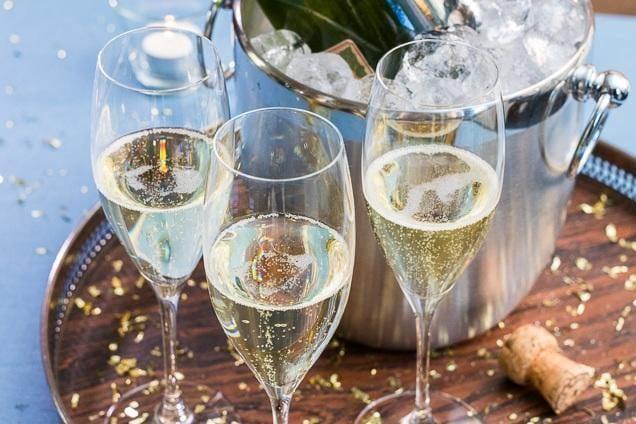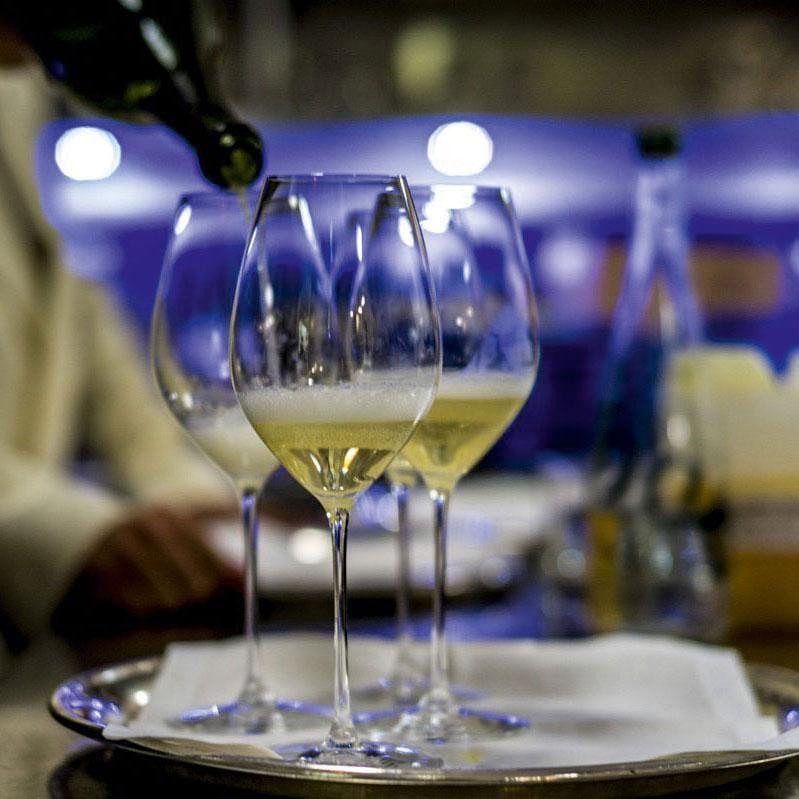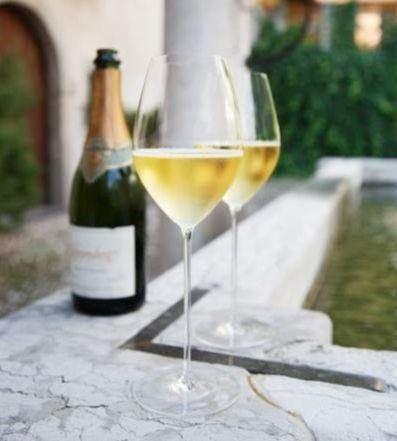All You Ever Wanted To Know About Champagne

- I only drink champagne when I’m happy, and when I’m sad. Sometimes I drink it when I’m alone. When I have company, I consider it obligatory. I trifle with it if I am not hungry and drink it when I am. Otherwise I never touch it—unless I’m thirsty.”
–Lily Bollinger, former manager of the Bollinger Champagne house

Andi Healey
Web Manager
History
Effervescence has been observed in wine throughout history and was noted by Ancient Greek and Roman writers, but the cause of this mysterious appearance of bubbles was not understood. Over time it has been attributed to phases of the moon as well as both good and evil spirits.
The tendency of still wine from the Champagne region to lightly sparkle was noted in the Middle Ages, but this was considered a fault and was disdained in early Champagne winemaking. Dom Pérignon was originally charged by his superiors at the Abbey of Hautvillers to get rid of the bubbles, since the pressure in the bottles caused many of them to burst in the cellar.
Later, when deliberate sparkling wine production increased, in the early 18th century, cellar workers would still have to wear a heavy iron mask, that resembled a baseball catcher's mask, to prevent injury from spontaneously bursting bottles.
The disturbance caused by one bottle's explosion could cause a chain reaction, with it being routine for cellars to lose up to 90% of their bottles to instability.
The mysterious circumstance surrounding the, then unknown, process of fermentation and carbonic gas caused some critics to call the sparkling creations "The Devil's Wine". (I'm sure it's been called that on many a "morning after" in my house!)
- “Only the unimaginative can fail to find a reason for drinking champagne.”
- Oscar Wilde

Christopher Merret, a Champagne cellar worker, complete with mask and Dom Pérignon "inventing" Champagne.
The British were the first to see the tendency of wines from Champagne to sparkle as a desirable trait and tried to understand why it produced bubbles.
Wine was often transported to England in wooden wine barrels, where merchant houses would then bottle the wine for sale.
During the 17th century, English glass production used coal-fueled ovens and produced stronger, more durable glass bottles than the wood-fired French glass.
The English also rediscovered the use of cork stoppers, once used by the Romans but forgotten for centuries after the fall of the Western Roman Empire. During the cold winters of the Champagne region, temperatures would drop so low that the fermentation process was prematurely halted, leaving behind some residual sugar and dormant yeast.
When the wine was shipped to, and bottled in England, the fermentation process would restart as the weather warmed and the cork-stoppered wine would begin to build pressure from carbon dioxide. Thus, when the wine was opened, it would be bubbly.
In 1662, the English scientist Christopher Merret presented a paper detailing how the presence of sugar in wine led to it eventually sparkling and, that by adding sugar to a wine before bottling it, nearly any wine could be made to sparkle. This is one of the first known accounts of understanding the process of sparkling wine and even suggests that British merchants were producing "sparkling Champagne" almost 30 years before Dom Pérignon and the French Champenois were deliberately making it.
What makes Champagne Champagne?
Champagne is produced at the far extreme of viticultural possibilities, where the grape struggles to ripen in a long drawn out growing season. A cool climate limits the varieties of grape, and the types of wine that can be made, but it is in this region that sparkling wine has found its pinnacle. The limestone–chalk soil produces grapes that have a certain balance of acidity and richness that is difficult to replicate in other parts of the world. The Champenois vigorously defend use of the term "Champagne" to relate the specific wine produced in their region. This includes objection to the term "Champagne style" to refer to sparkling wines produced elsewhere. Since 1985, use of the term "methode champenoise" has been banned in all wines produced or sold in the European Union.
Blending is the hallmark of Champagne wine, with most Champagnes being the assembled product of several vineyards and vintages. In Champagne there are over 19,000 vineyards, only 5,000 of which are owned by Champagne producers. The rest sell their grapes to the various Champagne houses, negociants and co-operatives. The grapes, most commonly Chardonnay, Pinot noir and Pinot meunier (one white and two red grapes) are used to make several base wines that are assembled together to make Champagne. Each grape adds its own unique contribution to the result. Chardonnay is prized for its finesse and aging ability. Pinot noir adds body and fruit while Pinot meunier contributes substantially to the aroma, adding fruit and floral notes.
The majority of Champagnes produced are non-vintage (or rather, multi-vintage) blends.
Vintage Champagne, often a house's most prestigious and expensive wine, is, obviously, produced, but only in years when the producers feel that the grapes have the complexity and richness to warrant it.
- "A single glass of champagne imparts a feeling of exhilaration. The nerves are braced; the imagination is stirred; the wits become more nimble."
- Winston Churchill
Bubbles (A nerd's guide)
An initial burst of effervescence occurs when the sparkling wine contacts a dry glass on pouring. These bubbles form on imperfections in the glass that facilitate nucleation (this is why all Riedel Champagne glasses have a small, etched dot, at the bottom of the bowl.
A "deliberate imperfection"). Nucleations are needed to stimulate the formation of bubbles, because carbon dioxide has to first diffuse from the wine solution before it can rise out of the glass and into the air.
A poured glass of sparkling wine will lose its bubbliness and carbon dioxide gas much more quickly than an open bottle alone would.
The frothiness or "mousse" of the wine, along with the average size and consistency of the bubbles, can vary depending on the quality of the wine and the type (and cleanliness) of glass used.
The average bottle of Champagne contains enough carbon dioxide to, potentially, produce 49 million bubbles. The bubbles initially form at 20 micrometers in diameter and expand as they gain buoyancy and rise to the surface. When they reach the surface they are approximately 1 millimeter in size.
It is speculated that the bubbles in sparkling wine may speed up alcohol intoxication by helping the alcohol to reach the bloodstream faster.
A study conducted at the University of Surrey gave subjects equal amounts of flat and sparkling Champagne which contained the same levels of alcohol.
After 5 minutes following consumption, the group that had the sparkling wine had 54 milligrams of alcohol in their blood while the group that had the same sparkling wine, only flat, had 39 milligrams.
- "Too much of anything is bad, but too much Champagne is just right."
- Mark Twain
What makes Champagne Champagne?
Champagne is produced at the far extreme of viticultural possibilities, where the grape struggles to ripen in a long drawn out growing season. A cool climate limits the varieties of grape, and the types of wine that can be made, but it is in this region that sparkling wine has found its pinnacle. The limestone–chalk soil produces grapes that have a certain balance of acidity and richness that is difficult to replicate in other parts of the world. The Champenois vigorously defend use of the term "Champagne" to relate the specific wine produced in their region. This includes objection to the term "Champagne style" to refer to sparkling wines produced elsewhere. Since 1985, use of the term "methode champenoise" has been banned in all wines produced or sold in the European Union.
Blending is the hallmark of Champagne wine, with most Champagnes being the assembled product of several vineyards and vintages. In Champagne there are over 19,000 vineyards, only 5,000 of which are owned by Champagne producers. The rest sell their grapes to the various Champagne houses, negociants and co-operatives. The grapes, most commonly Chardonnay, Pinot noir and Pinot meunier (one white and two red grapes) are used to make several base wines that are assembled together to make Champagne. Each grape adds its own unique contribution to the result. Chardonnay is prized for its finesse and aging ability. Pinot noir adds body and fruit while Pinot meunier contributes substantially to the aroma, adding fruit and floral notes.
The majority of Champagnes produced are non-vintage (or rather, multi-vintage) blends.
Vintage Champagne, often a house's most prestigious and expensive wine, is, obviously, produced, but only in years when the producers feel that the grapes have the complexity and richness to warrant it.
- "There comes a time in every woman's life when the only thing that helps is a glass of champagne."
- Bette Davis



